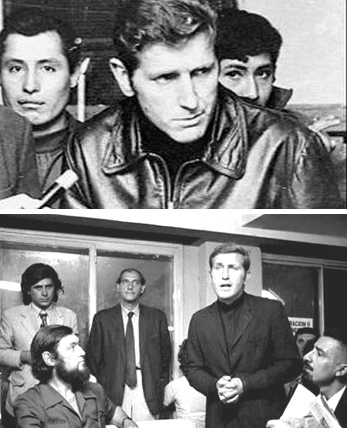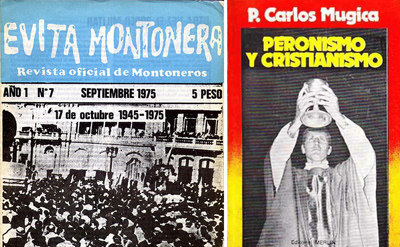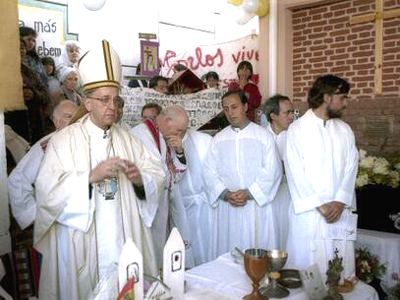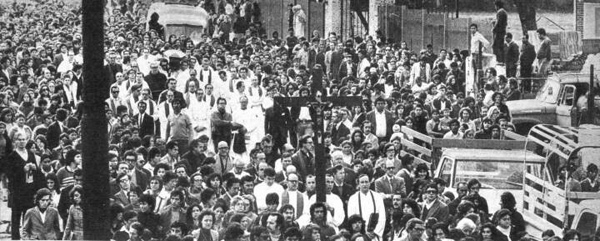Socio-Political Issues
 |
 |
 |
 |
 |
 |
 |
The Slum Priests of Archbishop Bergoglio
The front page of the Los Angeles Times on August 6, 2013 printed an article by Kate Linthicum reporting from Buenos Aires. The title reads“‘Slum priests’ endeavor to aid, not to convert.” Other subtitles and captions read; “’Slum priests’ fight for the poor,” and “Pope Francis, once the city’s archbishop, made the ‘slum priests’ a priority.”
 This article is about the slum priest movement in Buenos Aires, its Marxist origin and its “star” Fr. Carlos Mugica. Most importantly, the article reports how this movement was revived and “prioritized” by the then-Archbishop of Buenos Aires, Jorge Mario Bergoglio, who, now as Pope Francis, still supports this movement.
This article is about the slum priest movement in Buenos Aires, its Marxist origin and its “star” Fr. Carlos Mugica. Most importantly, the article reports how this movement was revived and “prioritized” by the then-Archbishop of Buenos Aires, Jorge Mario Bergoglio, who, now as Pope Francis, still supports this movement.
In her article, Linthicum describes one priest, Fr. Olivero, who works in the slums of Buenos Aires and is “part of a line of ‘slum priests’ who have worked for decades in the sprawling shantytowns worlds away from the tango salons and Parisian café culture of the other Buenos Aires.”
On that movement’s origin, we are also informed that “the slum priest tradition started as a political statement. In the 1960s, a group of priests inspired by Marxist ideology moved into the villas miserias [slums] and other working-class neighborhoods and started rallying for workers’ rights and social programs. They called themselves the Third World Priest Movement. The group’s star was Fr. Carlos Mugica, a charismatic orator with John F. Kennedy good looks who came from a prominent family, but preached about fighting alongside the poor for their liberation.”
For those who do want to know more about Fr. Mugica, below are just a few notes about his radical communist activities: It is interesting to note that, without mentioning Council Vatican II, Linthicum points to the about-face of the Catholic Hierarchy since Vatican II: “Decades later, their movement revived [the Third World Priest or Slum Priest Movement], the new generation of activist priests carrying on Mugica’s legacy could be described as iconoclasts – if they didn’t have support from the highest ranks of the Catholic Church.”
It is interesting to note that, without mentioning Council Vatican II, Linthicum points to the about-face of the Catholic Hierarchy since Vatican II: “Decades later, their movement revived [the Third World Priest or Slum Priest Movement], the new generation of activist priests carrying on Mugica’s legacy could be described as iconoclasts – if they didn’t have support from the highest ranks of the Catholic Church.”
In other words, those who before the Council attacked and tried to break the Church were later supported by the “highest ranks” of the Hierarchy
Indeed, Archbishop Bergoglio was the main supporter of that movement and made the revival and growth of the Slum Priests and the work of Fr. Mugica a priority:
“Jorge Mario Bergoglio, who served as Archbishop of Buenos Aires for 15 years before taking the title of Pope Francis this year, made the slum priests a priority. He tripled their numbers and gave them a special rank. He opened new chapels, paid to repair worn-down soccer fields and visited them frequently, usually arriving on his own by city bus.”
After Mugica was killed, Bergoglio “worked to resurrect the memory of Mugica. In 1999, he led a procession in which the radical priest’s remains were exhumed from an aristocratic cemetery and reburied in the chapel in the villa where he had lived.”
Bergoglio even changed the priestly rules to facilitate things for the new communist priests. When Fr. Olivero was training to be a priest, he “quickly grew tired of studying theology from books and wanted a more direct experience with his faith, and he was in luck. Bergoglio, the Archbishop of Buenos Aires, had changed the rules to allow some priests to pursue their studies outside the classroom.”
The work of these Bergoglio-supported priests was all social oriented: “Olivero and the other priests opened a drug rehabilitation center and painted it with murals of Mugica. They hired social workers. … With Bergoglio’s help, the priests also opened up rehabilitation work farms.”
 The precedence of the material over the spiritual, the basic error of the ‘slum priest’ movement, is also the presupposition of the condemned modernist Sillon movement, the Catholic Worker movement, as well as the Distributist movement being spread today in Catholic Traditionalist circles.
The precedence of the material over the spiritual, the basic error of the ‘slum priest’ movement, is also the presupposition of the condemned modernist Sillon movement, the Catholic Worker movement, as well as the Distributist movement being spread today in Catholic Traditionalist circles.
As the L.A. Times reports, “He [the slum priest Fr. Olivero] said his first focus is on helping people, not converting them.”
Even after his rise to the throne of the Papacy, Bergoglio has not ceased his support of that communist movement of priests. Linthicum reports:
“In recent months, the Pope has continued to keep tabs on the slum priests. On the fifth anniversary of the drug treatment center, he called a staffer and asked if he could relay a message. He said, ‘Don’t let them steal your hope,’ reports Sylvina Premat, a journalist who has written about the slum priests.”
These data gathered by the L.A. Times allow us to affirm without a doubt that Jorge Bergoglio, during the time he was Archbishop of Buenos Aires and now as Pope, gives full support to a communist movement of priests in Argentina. The characteristics of the movement show that it was not only Marxist inspired, but had close links with the communist-terrorist Montoneros guerillas in Argentina. It seems to me that this makes the Slum Priests movement as dangerous as the communist Brazilian Liberation Theology.
This report gives us yet another demonstration of the communist-friendly profile of Pope Bergoglio.


Posted August 19, 2013

Top, Fr. Carlos Mugica; bottom, delivering a talk to his communist friends
In her article, Linthicum describes one priest, Fr. Olivero, who works in the slums of Buenos Aires and is “part of a line of ‘slum priests’ who have worked for decades in the sprawling shantytowns worlds away from the tango salons and Parisian café culture of the other Buenos Aires.”
On that movement’s origin, we are also informed that “the slum priest tradition started as a political statement. In the 1960s, a group of priests inspired by Marxist ideology moved into the villas miserias [slums] and other working-class neighborhoods and started rallying for workers’ rights and social programs. They called themselves the Third World Priest Movement. The group’s star was Fr. Carlos Mugica, a charismatic orator with John F. Kennedy good looks who came from a prominent family, but preached about fighting alongside the poor for their liberation.”
For those who do want to know more about Fr. Mugica, below are just a few notes about his radical communist activities:
- He was a revolutionary priest of Christ the Worker Chapel in the slums of Buenos Aires;
- He sponsored symposiums in the 1960s for “Dialogue between Catholics and Marxists”;
- He went on a mission to Bolivia in 1967 to recover the remains of the communist revolutionary Che Guevara;
- He was a member of the leftist Young Catholic Students organization (JEC) and had ties to the terrorist-communist Montoneros guerillas;
- He defied orders of his bishop by presiding over the September 1970 funerals of a number of killed Montoneros members, which lead to his suspension for 30 days;
- During a trip to Paris, he supported the May 1968 Sorbonne Revolution;
- Peron [Juan Carlos Peron, a famous populist leader], who was allied to the communists in Argentina, spent 10 days in Cuba with Fr. Mugica who, on his return from Paris, joined the Movement of Priests for the Third World.

Left, the name of Evita, Peron's wife, was chosen by the Montonero guerilla for its magazine; right, Fr. Mugica wrote a book supporting Peronism
In other words, those who before the Council attacked and tried to break the Church were later supported by the “highest ranks” of the Hierarchy
Indeed, Archbishop Bergoglio was the main supporter of that movement and made the revival and growth of the Slum Priests and the work of Fr. Mugica a priority:
“Jorge Mario Bergoglio, who served as Archbishop of Buenos Aires for 15 years before taking the title of Pope Francis this year, made the slum priests a priority. He tripled their numbers and gave them a special rank. He opened new chapels, paid to repair worn-down soccer fields and visited them frequently, usually arriving on his own by city bus.”
After Mugica was killed, Bergoglio “worked to resurrect the memory of Mugica. In 1999, he led a procession in which the radical priest’s remains were exhumed from an aristocratic cemetery and reburied in the chapel in the villa where he had lived.”
Bergoglio even changed the priestly rules to facilitate things for the new communist priests. When Fr. Olivero was training to be a priest, he “quickly grew tired of studying theology from books and wanted a more direct experience with his faith, and he was in luck. Bergoglio, the Archbishop of Buenos Aires, had changed the rules to allow some priests to pursue their studies outside the classroom.”
The work of these Bergoglio-supported priests was all social oriented: “Olivero and the other priests opened a drug rehabilitation center and painted it with murals of Mugica. They hired social workers. … With Bergoglio’s help, the priests also opened up rehabilitation work farms.”

Long after Mugica was killed, Archbishop Bergoglio said a Mass in a slum area, under a placard reading: "Carlos lives"
As the L.A. Times reports, “He [the slum priest Fr. Olivero] said his first focus is on helping people, not converting them.”
Even after his rise to the throne of the Papacy, Bergoglio has not ceased his support of that communist movement of priests. Linthicum reports:
“In recent months, the Pope has continued to keep tabs on the slum priests. On the fifth anniversary of the drug treatment center, he called a staffer and asked if he could relay a message. He said, ‘Don’t let them steal your hope,’ reports Sylvina Premat, a journalist who has written about the slum priests.”
These data gathered by the L.A. Times allow us to affirm without a doubt that Jorge Bergoglio, during the time he was Archbishop of Buenos Aires and now as Pope, gives full support to a communist movement of priests in Argentina. The characteristics of the movement show that it was not only Marxist inspired, but had close links with the communist-terrorist Montoneros guerillas in Argentina. It seems to me that this makes the Slum Priests movement as dangerous as the communist Brazilian Liberation Theology.
This report gives us yet another demonstration of the communist-friendly profile of Pope Bergoglio.

May 1974 - The funeral of Fr. Mugica became a leftist manifestation with the presence of all villa priests of Buenos Aires; later in 1998, they were supported by Archbishop Bergoglio

Posted August 19, 2013
______________________
______________________











